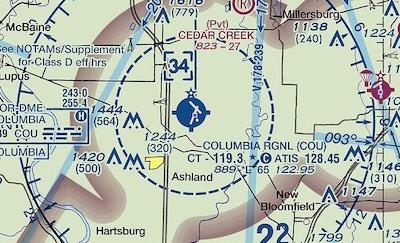Sat, Apr 20, 2019
Emergency Runway Alterations Completed, But Questions Remain About Who Will Pay For Them
Emergency runway alterations have been completed at Columbia (MO) Regional Airport (KCOU), reopening the field to both GA and scheduled passenger service.

The airport had been closed a week ago Monday after airport officials say two of the three airlines that serve the airport suspended operations because of problems with the main runway. The crown of the main runway at the intersection with the secondary runway was causing rough landings, the airlines said. The crown was milled down over the course of the last week and the runway was repaved.
The problems came to light when the 6,500-foot main runway was closed on April 1 as the city began a $6 million project to refurbish and lengthen it. The crossing runway was rebuilt two years ago and lengthened to 5,500 feet, and was being used by the airlines while construction was being done on the main runway.
The milling and repaving project cost about $500,000, and The Columbia Daily Tribune reports that interim City Manager John Glascock said that the FAA would be required to pay for the repairs. But FAA regional spokeswoman Elizabeth Cory said in an email to the paper that federal funding is not automatic, and an AIP grant would not cover the full cost of the project.
In the email sent to the paper, Cory raised questions about Glascock's assumption that the FAA would pay for the modifications. But Glascock told the board of Regional Economic Development Inc. that the crown is necessary to drain water off the runway, and was built to federal specifications. Cory said that the FAA does not require drainage crowns to continue through a runway intersection. "FAA design standards call for designers to, 'Provide a smooth transition between intersecting pavement surfaces as well as adequate drainage of the intersection,'" she wrote.
She also questioned why the crown had suddenly become a problem 18 months after the project was complete.
The intersection was created when the secondary runway was extended. That runway had previously terminated where it joined the main runway at a skewed angle, according to the report.
More News
Aero Linx: Model Aeronautical Association of Australia MAAA clubs are about fun flying, camaraderie and community. For over 75 years, the MAAA has been Australia’s largest fl>[...]
Touchdown Zone Lighting Two rows of transverse light bars located symmetrically about the runway centerline normally at 100 foot intervals. The basic system extends 3,000 feet alon>[...]
“Discovery and innovation are central to our mission at Virgin Galactic. We’re excited to build on our successful record of facilitating scientific experiments in subor>[...]
How To Get A Story On Aero-TV News/Feature Programming How do I submit a story idea or lead to Aero-TV? If you would like to submit a story idea or lead, please contact Jim Campbel>[...]
Student Pilot Reported That During Rotation, “All Of A Sudden The Back Of The Plane Kicked To The Right..." Analysis: The student pilot reported that during rotation, “>[...]
 ANN's Daily Aero-Linx (05.02.24)
ANN's Daily Aero-Linx (05.02.24) ANN's Daily Aero-Term (05.02.24): Touchdown Zone Lighting
ANN's Daily Aero-Term (05.02.24): Touchdown Zone Lighting Aero-News: Quote of the Day (05.02.24)
Aero-News: Quote of the Day (05.02.24) ANN FAQ: Contributing To Aero-TV
ANN FAQ: Contributing To Aero-TV NTSB Final Report: Cirrus Design Corp SR20
NTSB Final Report: Cirrus Design Corp SR20



